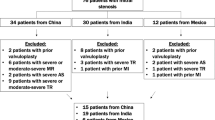Abstract
Rheumatic heart disease (RHD) is a major cause of morbidity and mortality in developing countries, so early diagnosis and treatment can reduce morbidity and mortality resulting from subsequent valvular damage. The aim of this study was to detect subtle myocardial dysfunction among children with RHD with preserved left ventricular systolic function. This is a cross-sectional case–control study that was conducted on 30 children with RHD (who had valvular affection of any degree and were not in activity) compared to 23 healthy children. After history taking and cardiac examination, 2D echocardiography, tissue Doppler imaging, 3D-echocardiography and 3D speckle tracking echocardiography were done to both groups, whereas cardiac magnetic resonance imaging was done only to the patient group. The 3D-derived left ventricular end-diastolic volume and sphericity index among patients were significantly increased when compared to controls [131.5 (101.5 to 173.7) vs. 69 (58 to 92), P = 0.001, and 0.46 (0.36 to 0.59) vs. 0.33 (0.29 to 0.38), P = 0.001, respectively]. The 3D-derived ejection fraction and longitudinal strain did not differ significantly among both groups. The 3D-derived global circumferential strain was higher in patients when compared to controls [− 14 (− 16 to − 10) vs. − 11(− 13 to − 10), P = 0.04]. None of the examined patients demonstrated late enhancement myocardial fibrosis. In children with RHD and preserved systolic function, subtle systolic dysfunction could not be detected using conventional and novel non-conventional methods. This may indicate that the myocardial affection during the acute stage of rheumatic carditis is minimal with almost complete resolution.
Similar content being viewed by others
References
Seckeler MD, Hoke TR (2011) The worldwide epidemiology of acute rheumatic fever and rheumatic heart disease. Clin Epidemiol 3:67–84. https://doi.org/10.2147/CLEP.S12977
Monaghan MJ (2006) Role of real time 3D echocardiography in evaluating the left ventricle. Heart 92:131–136. https://doi.org/10.1136/hrt.2004.058388
Shibayama K, Watanabe H, Iguchi N et al (2013) Evaluation of automated measurement of left ventricular volume by novel real-time 3-dimensional echocardiographic system: Validation with cardiac magnetic resonance imaging and 2-dimensional echocardiography. J Cardiol 61:281–288. https://doi.org/10.1016/j.jjcc.2012.11.005
Ho CY, Solomon SD (2006) A clinician’s guide to tissue doppler imaging. Circulation 113:396–399. https://doi.org/10.1161/CIRCULATIONAHA.105.579268
Mor-Avi V, Lang RM, Badano LP et al (2011) Current and evolving echocardiographic techniques for the quantitative evaluation of cardiac mechanics: ASE/EAE consensus statement on methodology and indications endorsed by the Japanese Society of Echocardiography. Eur J Echocardiogr 12:167–205. https://doi.org/10.1093/ejechocard/jer021
Altman M, Bergerot C, Aussoleil A et al (2014) Assessment of left ventricular systolic function by deformation imaging derived from speckle tracking: A comparison between 2D and 3D echo modalities. Eur Heart J Cardiovasc Imaging 15:316–323. https://doi.org/10.1093/ehjci/jet103
Vogel M (2002) Validation of myocardial acceleration during isovolumic contraction as a novel noninvasive index of right ventricular contractility: comparison with ventricular pressure-volume relations in an animal model. Circulation 105:1693–1699. https://doi.org/10.1161/01.CIR.0000013773.67850.BA
Vieira MLC, Oliveira WA, Cordovil A et al. 3D Echo pilot study of geometric left ventricular changes after acute myocardial infarction. Arq Bras Cardiol 101:43–51. https://doi.org/10.5935/abc.20130112
Karthikeyan G, Zühlke L, Engel M et al (2012) Rationale and design of a global rheumatic heart disease registry: the REMEDY study. Am Heart J 163:535–40.e1. https://doi.org/10.1016/j.ahj.2012.01.003
Carapetis J, Brown A, Maguire G, Walsh W (2012) The Australian guideline for prevention, diagnosis and management of acute rheumatic fever and rheumatic heart disease. Heal. https://doi.org/10.1016/j.hlc.2007.12.002
Otterstad JE, Froeland G, St John Sutton M, Holme I (1997) Accuracy and reproducibility of biplane two-dimensional echocardiographic measurements of left ventricular dimensions and function. Eur Heart J 18:507–513. https://doi.org/10.1093/oxfordjournals.eurheartj.a015273
Guven S, Sen T, Tufekcioglu O et al (2014) Evaluation of left ventricular systolic function with pulsed wave tissue doppler in rheumatic mitral stenosis. Cardiol J 21:33–38. https://doi.org/10.5603/CJ.a2013.0058
Lee LC, Zhihong Z, Hinson A, Guccione JM (2013) Reduction in left ventricular wall stress and improvement in function in failing hearts using algisyl-LVR. J Vis Exp. https://doi.org/10.3791/50096
Torrent-Guasp F, Kocica MJ, Corno A et al (2004) Systolic ventricular filling. Eur J Cardio-thoracic Surg 25:376–386. https://doi.org/10.1016/j.ejcts.2003.12.020
Kayıkçıoğlu M (2010) Pulmoner hipertansiyonda etiyopatogenez: inflamasyon, vasküler yeniden şekillenme. Anadolu Kardiyol Derg 10:5–8. https://doi.org/10.5152/akd.2010.113
Younan H (2013) Role of two dimensional strain and strain rate imaging in assessment of left ventricular systolic function in patients with rheumatic mitral stenosis and normal ejection fraction. Egypt Hear J 67:193–198. https://doi.org/10.1016/j.ehj.2014.07.003
Bryant PA, Robins-Browne R, Carapetis JR, Curtis N (2009) Some of the people, some of the time susceptibility to acute rheumatic fever. Circulation 119:742–753. https://doi.org/10.1161/CIRCULATIONAHA.108.792135
Essop MR, Wisenbaugh T, Sareli P (1993) Evidence against a myocardial factor as the cause of left ventricular dilation in active rheumatic carditis. J Am Coll Cardiol 22:826–829. https://doi.org/10.1016/0735-1097(93)90197-9
Nishimura RA, Abel MD, Hatle LK, Tajik AJ (1989) Assessment of diastolic function of the heart: background and current applications of Doppler echocardiography. Part II. Clinical studies. Mayo Clin Proc 64:181–204
Greenberg NL, Firstenberg MS, Castro PL et al (2002) Doppler-derived myocardial systolic strain rate is a strong index of left ventricular contractility. Circulation 105:99–105. https://doi.org/10.1161/hc0102.101396
Gaasch WH, Levine HJ, Quinones MA, Alexander JK (1976) Left ventricular compliance: mechanisms and clinical implications. Am J Cardiol 38:645–653
Mona S, Jain KH, Sharma ND, Jadhav, Komal H, Shah A, Konat (2015) Tissue doppler imaging in rheumatic mitral valve disease patients for the assessment of left ventricular function. Am J Adv Med Surg Res 1(1):3–8
Funding
This research received no grant from any funding agency in the public, commercial or not-for-profit sectors.
Author information
Authors and Affiliations
Corresponding author
Ethics declarations
Conflict of interests
The authors declare that there is no conflict of interests.
Ethical Standard
All procedures that were performed were in accordance with the ethical standards of the Kasr Al Ainy Research Committee and with the 1964 Helsinki declaration and its later amendments or comparable ethical standards. The study protocol was approved by the institutional review board.
Rights and permissions
About this article
Cite this article
Sobhy, R., Samir, M., Abdelmohsen, G. et al. Subtle Myocardial Dysfunction and Fibrosis in Children with Rheumatic Heart Disease: Insight from 3D Echocardiography, 3D Speckle Tracking and Cardiac Magnetic Resonance Imaging. Pediatr Cardiol 40, 518–525 (2019). https://doi.org/10.1007/s00246-018-2006-5
Received:
Accepted:
Published:
Issue Date:
DOI: https://doi.org/10.1007/s00246-018-2006-5




